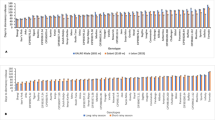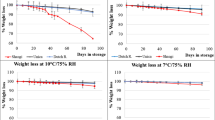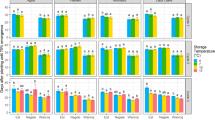Abstract
In potato breeding and selection, storability should be regarded as equally important as yield, disease resistance, and quality. A study documenting the dormancy period, sprouting behavior, and weight loss of 17 International Potato Center potato elite and advanced clones was carried out in Tashkent, Uzbekistan, under cellar and cold store conditions, during 2008 and 2009. Ninety tubers of each of 17 clones were allocated to experimental units of 30 tubers each placed in trays and randomized in three replications following a random complete block design. Therefore, there were three replications of 30 seed tubers each per entry. The dormancy period ranged from 77 to 115 days and from 100 to 186 days under cellar and cold storage, respectively. There was a relatively high positive correlation (0.69) for dormancy period between storage systems, indicating that clones demonstrating longer and shorter dormancy periods under one system will also behave similarly under the other system. A negative correlation (−0.53 and −0.88) was found between dormancy period and length of the longest sprout in cellar and cold store, respectively, meaning that clones with shorter dormancy often showed a greater length of their longest sprout. The weight loss percentage per tuber was similar in both storage systems, from 5.0% to 8.0% in the cellar and from 5.0% to 9.8% in the cold store, although for different storage periods (an average of 110 and 166 days under cellar and cold storage conditions, respectively). The study indicated that under cellar conditions, clones with a longer dormancy period and slower rate of sprout growth have less weight loss during storage and therefore better keeping quality.
Similar content being viewed by others
References
Beukema HP, van der Zaag DE (1979) Potato improvement: some factors and facts. IAC, Wageningen
Burton WG (1955) Biological and economic aspects of the refrigerated storage of potatoes. Proc Inst Refrigeration 51:168–172
Burton WG (1989) Dormancy and sprout growth. In: Burton WG (ed) The potato, 3rd edn. Longman, Harlow, pp 471–504
CIP (2007) Procedures for standard evaluation trials of advanced potato clones. An International Cooperators’ guide. The International Potato Center, Lima
Ezekiel R, Singh B (2003) Seed physiology. In: Khurana SMP, Minhas JS, Pandey SK (eds) The potato production and utilization in sub tropics. Mehta, New Delhi, pp 301–313
Mihovilovich E, Carli C, Bonierbale M (2010) Assessment of dormancy and sprouting behavior of elite and advanced clones. The International Potato Center (CIP), Lima, Peru, unpublished
MSTAT-C (1993) A microcomputer program for the design, management and analysis of agronomic research experiments. Michigan State University, East Lansing
Pande PC, Singh SV, Pandey SK, Singh B (2007) Dormancy, sprouting behavior and weight loss in Indian potato (Solanum tuberosum) varieties. Indian J Agric Sci 77:715–720
Pavlista AD (2004) Physiological aging of seed tubers. Nebr Potato Eyes 16(1):1–4
Reust W (1986) Physiological age of the potato. Potato Res 29:268–271
Roztropowicz S, Wardzynska H (1974) Observation of tuber dormancy in twenty Polish potato varieties. Biul Inst Ziemn 14:147–164
Singh B, Ezekiel R (2003) Studies on dormancy, sprout growth and weight loss in some old and new potato varieties under controlled temperature conditions. Seed Res 31:47–52
Susnoschi M (1981) Seed potato quality as influenced by high temperatures during the growth period. 2. Sprouting pattern in several cultivars in response to storage temperature. Potato Res 24:381–388
van der Zaag DE (1992) Potatoes and their cultivation in The Netherlands. The Netherlands Potato Consultative Institute and the Ministry of Agriculture and Fisheries, Foreign Information Service, Den Haag
van Es A, Hartmans KJ (1987) Dormancy, sprouting and sprout inhibition. In: Rastovski A, van Es A (eds) Storage of potatoes. Pudoc, Wageningen, pp 114–132
van Ittersum MK, Scholte K (1992) Shortening dormancy of seed potatoes by storage temperature regimes. Potato Res 35:389–401
Wiltshire JJJ, Cobb AH (1996) A review of the physiology of potato tuber dormancy. Ann Appl Biol 129:553–569
Wurr DCE (1978) Studies of the measurements and interpretation of potato sprout growth. J Agric Sci (Cambridge) 90:335–340
Acknowledgments
The authors thank NARS of Uzbekistan for the assistance provided throughout the whole experiment.
Author information
Authors and Affiliations
Corresponding author
Rights and permissions
About this article
Cite this article
Carli, C., Mihovilovich, E., Yuldashev, F. et al. Assessment of Dormancy and Sprouting Behavior of CIP Elite and Advanced Clones Under Different Storage Conditions in Uzbekistan. Potato Res. 53, 313–323 (2010). https://doi.org/10.1007/s11540-010-9172-z
Received:
Accepted:
Published:
Issue Date:
DOI: https://doi.org/10.1007/s11540-010-9172-z




